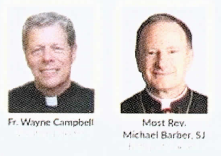St Junipero Serra, OFM
Our culture is facing a great upheaval in these months. Besides the legitimate civil protests, there are riots, violence … AND … the toppling of statues – a curious phenomenon. The most common reason claimed is to demean and dishonor previous historical figures who carried out some dishonorable activities – predominantly the owning of slaves, racism or mistreating indigenous peoples. The removal of statues is a legitimate topic, to be dealt with in the proper legal forum, not the uncertain onslaught of a mob. It is clear many of these mobs did not know their history because the statues of a couple of abolitionists have been toppled. Many of these are political figures, and who knows the full truth when it comes to politics, but what is offensive to us, as Catholics, is the toppling and desecration of statues of St Junipero Serra who, though he was a product of his times and culture, showed a dear love for his indigenous parishioners. To be canonized a saint does not mean that a person never sinned, even daily, but that they prayed and strove with heroic courage to overcome their personal defects with the sacraments, and then within their vocation, active or contemplative, strove to build up their society and overcome its defects. Even our president could be a canonized saint – I am thinking of Ashley at the moment.
Most Reverend José H. Gomez, Archbishop of Los Angeles, after meditating on the writings and sermons of St Junipero had the following comments — I understand the deep pain being expressed by some native peoples in California. But I also believe Fray Junípero is a saint for our times, the spiritual founder of Los Angeles, a champion of human rights, and this country’s first Hispanic saint … The exploitation of America’s first peoples, the destruction of their ancient civilizations, is a historic tragedy. Crimes committed against their ancestors continue to shape the lives and futures of native peoples today … In the family of God here in the Archdiocese of Los Angeles, we have worked hard to atone for past errors and wrongs and to find the path forward together … Over the years, I have come to understand how the image of Father Serra and the missions evokes painful memories for some people … Historical memory is the soul of every nation … But history is complicated. The facts matter, distinctions need to be made, and the truth counts … Our society may reach a consensus not to honor St. Junípero or various other figures from our past … But in many cases, it is clear that those attacking St. Junípero’s good name and vandalizing his memorials do not know his true character or the actual historical record … Many of the crimes and abuses that our saint is blamed for — slanders that are spread widely today over the Internet and sometimes repeated by public figures — actually happened long after his death … It was California’s first governor who called for “a war of extermination” against the Indians and called in the U.S. Cavalry to help carry out his genocidal plans. That was in 1851. St. Junípero died in 1784 … The tragic ruin of native populations occurred long after St. Junípero was gone and the missions were closed or “secularized” … The real St. Junípero fought a colonial system where natives were regarded as “barbarians” and “savages” … He lived and worked alongside native peoples and spent his whole career defending their humanity and protesting crimes committed against them … We find heartbreaking passages in his letters where he decries the daily sexual abuse of indigenous women by colonial soldiers … In his letters, he describes their “gentleness and peaceful dispositions,” he celebrates their creativity and knowledge … St. Junípero was 60 years old when he traveled 2,000 miles from Carmel to Mexico City to protest the injustices of the colonial system and demand that authorities adopt a “bill of rights” that he had written for the native peoples … Despite their many flaws, the California missions were similar to some of the other communes and “communitarian” societies we find in early American history.
We have reached the end of our seminarians on the poster at the back of our church. There are two pictures left – Vocations Director , Fr Wayne Campbell, and Bishop Barber. In our prayer for our seminarians and clergy, let us pray especially for these two, pictures shown below. Let us, also, invoke the name of St Serra and ask that he will help us overcome the ills of our society and get to heaven.
Dennis
